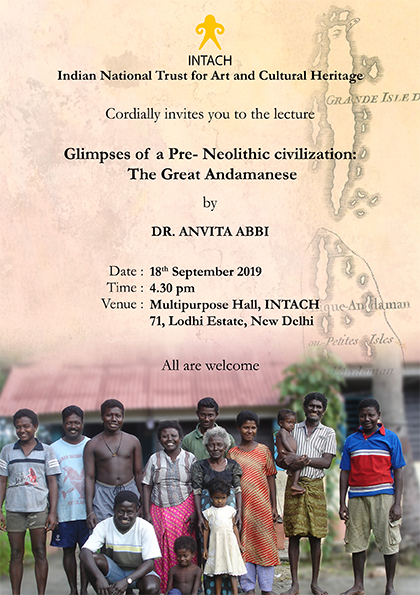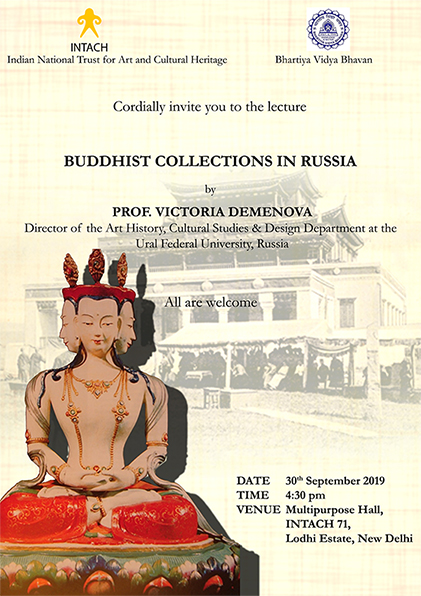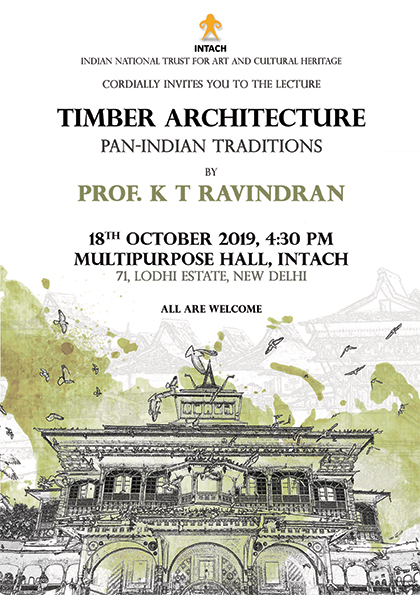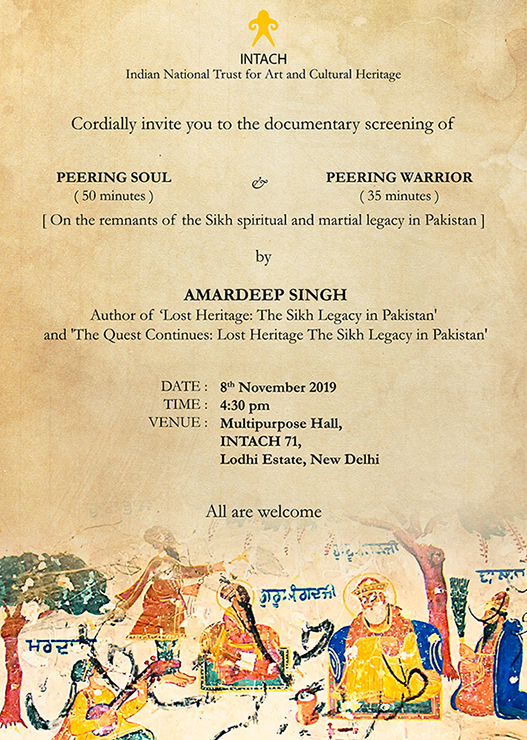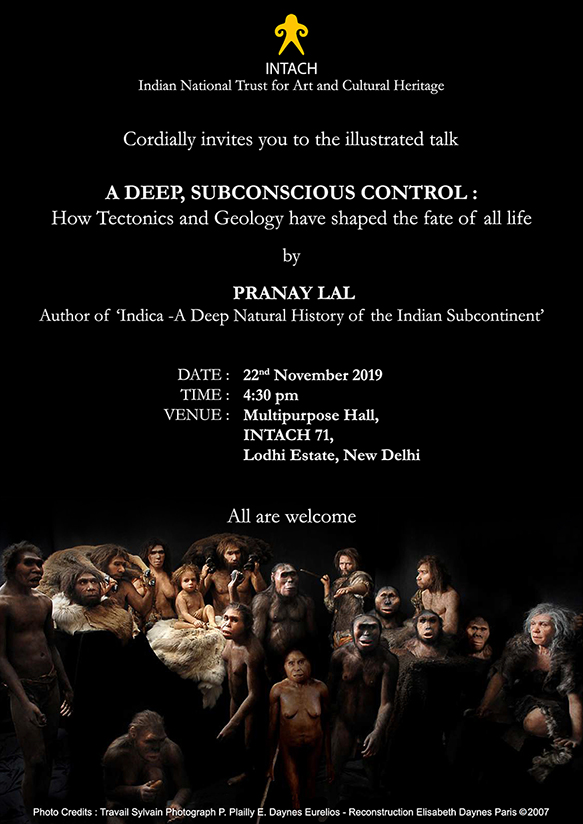Events Archives
-
Illustrated Talk ‘The Restoration of the Flora Fountain in Mumbai’by Mr. Nilabh Sinha
Date: 13th August 2019
Time: 4.30 pm
Location: Multipurpose Hall, INTACH, New DelhiIt gives us great pleasure to invite you to the illustrated talk at INTACH. Flora Fountain, built in 1864 is situated at the Fort in the heart of South Mumbai.
In 1860, the then Governor, Sir Bartle Frere demolished the Old Mumbai Fort as part of his efforts to improve civic sanitation and the urban space requirements of the growing city. Mumbai Fort was built between 1686 and 1743 by the British East India Company with three gates – the Apollo Gate, the Church gate and the Bazaar Gate, a moat, an esplanade, level open space on its western fringe and residences. Consequent to the demolition the Flora Fountain was erected at the exact place where the Church gate stood before its demolition.
INTACH was awarded the work of restoring the sculptures of the Flora Fountain by the Municipal Corporation of Greater Mumbai.
The illustrated talk will cover the stage-wise progression of the restoration process, how the challenging task of removing 25 layers of paint, vegetation and bio-deterioration was undertaken at the site without causing any harm to the original Portland stone. The site work led by INTACH Conservation Team under the supervision of Mr. Nilabh Sinha, was supported by controlled lab testing and the use of steam as a cleaning agent which proved to be highly effective.
Mr. Nilabh Sinha, Principal Director, Art & Material Heritage Division of INTACH and INTACH Conservation Institutes is involved in the management of various Art Conservation Centers in India. He did his Masters in ‘Conservation of works of art’ from the National Museum Institute and has been the project leader for many architectural and material conservation projects undertaken by INTACH as well as those involving museums and interpretation centers. He has also acquired knowledge in the recent trends in the field during his internship at international institutions like Hamilton Kerr Institute (Fitzwilliam Museum, UK), V&A Museum (London, UK), NMGM (Liverpool, UK). His vision has led to a change in the focus from conservation treatment approach to a more holistic heritage management approach which includes; continuous study and research, documentation, interpretation and display and to spread awareness for heritage conservation and preservation.
Mr. Sinha’s recent work has focused on developing indigenous and simple methods for conservation practices in India so that these can be easily followed by people/conservators who have limited resources.
-
Lecture on ‘Glimpses of a Pre-Neolithic Civilization: The Great Andamanese’ by Dr. Anvita Abbi
Date: 18th September 2019
Time: 4.30 pm
Location: Multipurpose Hall, INTACH, New DelhiIt gives us great pleasure to invite you to the lecture at INTACH. The genetic history of the Andamanese tribes in general, and the Great Andamanese tribe in specific, is highly important for understanding the evolution of modern humans. Research by geneticists indicates that the Andamanese are survivors of the first migration from Africa that took place 70,000 years before the present. They are the last representatives of pre-Neolithic Southeast Asia. Despite the fact that their language is on the brink of extinction, it has been painstakingly documented by the author (Abbi 2006, 2012, 2013). Present Great Andamanese (PGA) is an endangered and moribund language which is spoken by the Great Andamanese tribe who remained hunters and gatherers till the middle of the 20th century. Their language has retained structures which appear to be relics of the prehistoric human language/s and give us a clue of possibly the earliest ‘human language’ structure. The language of the Great Andamanese not only manifests various ecological and archaeological signatures of an ancient civilization but also reflects their indigenous knowledge-system concerning their flora and fauna, concept of time and space, and anthropocentric grammatical structures which reflect their unique worldview.
The present talk also showcases ethnographic account of endemic birds extensively categorized by the tribe (Pande and Abbi 2011). The talk will expose the audience to the original sound recordings of songs rendered by the native speakers of the dying language.
Dr. Anvita Abbi is formerly a Professor of Linguistics Jawaharlal Nehru University, New Delhi and currently Adjunct Professor of Linguistics, Simon Fraser University, B.C. Vancouver, Canada. And Visiting Research Professor, B.B. Borkar Chair, Goa University, Goa.
She has carried out first-hand field research on all six language families of India extending from the Himalayas to the Andaman Islands. She identified the sixth language family of India, viz. Great Andamanese. Her results were later corroborated by the geneticists. She has widely published in the areas of areal typology, language change, language documentation, structures of tribal and minority languages, language policy and education, and analysis of ethno-linguistic aspects of language use.
In the past, she has occupied positions of Guest Scientist at the Max Planck Institute of Evolutionary Anthropology at Leipzig, Germany, Leverhulme Professor at SOAS, University of London, England, Distinguished Visiting Fellow at La Trobe University, Melbourne, Australia, and Visiting Professorships in Heidelberg and Wuerzburg in Germany and at Simon Fraser University at Vancouver, B.C. Canada. She has been advisor to the UNESCO on language issues. She was the founder Director of the Centre for Oral and Tribal Literature at Sahitya Akademi, New Delhi. She taught Linguistics at JNU for 38 years. Currently she is busy documenting endangered languages of the Nicobar Islands.
An author and editor of 21 books published nationally and internationally, Dr. Abbi’s work on tribal and other minority languages of South Asia has been exemplary and she is the recipient several national and international awards including the Padma Shri in 2013 by the President of India and the Kenneth Hale Award in 2015 by the Linguistic Society of America for ‘outstanding lifetime contributions to the documentation and description of languages of India’ and Rashtriya Lok-Bhasha Sammaan in 2003 for her contribution to tribal languages of India.
-
Illustrated Lecture on ‘Buddhist Collections in Russia’by Dr. Victoria Demenova
Date: 30th September 2019
Time: 4.30 pm
Location: Multipurpose Hall, INTACH, New DelhiIt gives us great pleasure to invite you at INTACH for the lecture, which will review the history of three Buddhist regions of Russia (Buryatia, Tuva, Kalmykia) and the creation of specific styles of Buddhist Art (thangka and sculpture) in these territories highlighting their specific features. Dr. Demenova will also examine the history of museum collections of Buddhist Art in St. Petersburg and Moscow, the Urals and Siberia regions of Russia – The main researchers in these fields, their works and the specifics of studying Buddhist Art in Russia.
Victoria Demenova has a PhD in History of Arts and is the Dean of the Faculty of History of Arts, Cultural Studies and Design, Ural Federal University, Russia.
She is also the official expert for the Ministry of Culture of Russia (for the Ural region) in the field of Oriental art. Dr. Demenova is the Committee Chairperson of International Scientific Symposium on Buddhist Art: traditions and innovations (Ulan-Ude, Buryatia, Russia), committee chairperson research conference ‘QUESTIONS OF EXPERTISE IN CULTURE, ARTS AND DESIGN’ (Ekaterinburg, Russia).
Dr. Demenova has researched on the collection of Buddhist Art in the Central and Regional museums of Russia, different styles in Buddhist Art, cross-cultural aspects in ancient eastern and western arts.
Dr. Demenova has authored ‘Collection of Buddhist Sculpture of the Sverdlovsk Regional Museum of Local History’ and ‘Space of meanings of Buddhist metal sculpture’. She edited a collection of papers compiled for the book ‘Contemporary Buddhist art: traditions and innovations’ and ‘Buddhist Art in Eurasian Cultural Spaces: Diversity in Harmony’. In 2018 she co- authored the catalogue and organizer of the exhibition ‘Our East: Buddhist art in collections of 14th – 20th centuries in the museums and private collections’. The exhibition included a collection of the State Hermitage Museum (St. Petersburg), the Museum of Local History of the Urals, the Museum of Fine Arts of Yekaterinburg, the Museum of Fine Arts of Chelyabinsk and three private collections in Russia.
-
Lecture on ‘TIMBER ARCHITECTURE: Pan-Indian Traditions’ by Prof. K.T. Ravindran
Date: 18th October 2019
Time: 4.30 pm
Location: Multipurpose Hall, INTACH, New DelhiIt gives us great pleasure to invite you to the lecture at INTACH. Nuanced by culture and climate, timber architecture in India has taken multiple variations across the subcontinent. The tree has been worshipped in many cultures across India as the life-giver, embodiment of Enlightened Consciousness and the ultimate support for all sentient beings. Transformed into timber the tree becomes the foundation and superstructure of Gods’ and human abodes. Variations in timber have led to traditional building sciences which are codified and practiced based on the differing nature of timber across the landscape. From Kashmir to Kerala the use of timber, both as structural material and ornamentation excels as the most endearing building material, partnering stone, mud, bamboo and burnt brick. From snowy mountains to tropical sandy deserts, the presence of timber as building material is ubiquitous.
Prof. K.T. Ravindran, Chairman of the Architectural Heritage Advisory Committee of INTACH, is a Trustee of the Indian Heritage Cities Network Foundation and was Member of the Advisory Board for the United Nations Capital Master Plan, New York. He was also Senior Academic Advisor, RICS School of Built Environment and Member of the International Jury for the A.P. Capital Complex. He was formerly Vice Chairman of the Environmental Impact Assessment Committee, Government of India.
Prof. Ravindran taught Urban Design for three decades in SPA Delhi and was Founder President of the Institute of Urban Designers India. He is Member Governing Council of NID, Vijayawada, Member National Advisory Committee on HRIDAY cities, and Mentor for the Smart City Mission on Public Open Spaces. He was the former Chairman of Delhi Urban Art Commission. His practice includes design of green-field cities, cultural buildings, memorials, adaptive reuse and Urban Conservation. His works and research are published in journals and books internationally.
-
Illustrated Talk and Documentary Screening by Mr. Amardeep Singh
Date: 4th and 8th November 2019
Time: 4.30 pm
Location: Multipurpose Hall, INTACH, New DelhiIt gives us great pleasure to invite you to an illustrated talk ‘I Am You, You Are Me: Insights from mapping sites associated with Guru Nanak’s travels’ by Amardeep Singh.
Guru Nanak visited more than 150 interfaith sites across 9 countries to seek and impart spiritual wisdom. However, today due to inaccessibility to many of the regions, his narrative stands limited to a few sites.
We will also be screening two documentaries by Amardeep Singh – Peering Soul (50 minutes) and Peering Warrior (35minutes) on 8th November 2019 at 4.30pm in the Multipurpose Hall at INTACH. The two documentaries are based on candid footage captured during field research and give details of the remnants of the Sikh spiritual and martial legacy in Pakistan. Amardeep will be present at the screening for audience interaction.
Amardeep Singh studied Electronics Engineering at the Manipal Institute of Technology (India), and Masters of Business Administration at the University of Chicago (USA).
He spent 25 years in corporate roles and was the Head of Revenue Management (Asia Pacific region) at American Express, where he served for 21 years.
From 2014 he dedicated himself to research on Sikh Legacy remnants. He has authored two path-breaking books, titled, ‘Lost Heritage: The Sikh Legacy in Pakistan’ and ‘The Quest Continues: Lost Heritage The Sikh Legacy in Pakistan’. He has also made two documentaries detailing the remnants of the Sikh spiritual and martial legacy in Pakistan.
He is currently filming a multi-episode documentary ‘Allegory – A Tapestry of Guru Nanak’s Travels’. This is a first attempt to visually document the travels of Guru Nanak. The team has already completed the narrative in the toughest regions across Pakistan, Afghanistan, Iraq, Iran, Saudi Arabia, Bangladesh, Tibet and Sri Lanka, and the filming is now in process across India. The 600+ min multi-episode production will be completed by mid 2021.
-
Illustrated Talk on ‘A Deep Subconscious Control: How tectonics and geology have shaped the fate of all life’ by Pranay Lal
Date: 22nd November 2019
Time: 4.30 pm
Location: Multipurpose Hall, INTACH, New DelhiIt gives us great pleasure to invite you at INTACH for the talk. Geological events have shaped landscapes and climate and these are critical to explaining why things exist the way they do. All events in history, including the rise and fall of all lifeforms and human civilizations and dynasties, have been affected by deep natural history. Pranay Lal will share a 4.5 billion history of the subcontinent and show how they influenced and continue to shape our lives.
Pranay Lal is a biochemist by training and works for a non-profit organization on public health. He has been a caricaturist for newspapers, an animator for an advertising agency and an environmental campaigner. His first book, Indica -A Deep Natural History of the Indian Subcontinent was published by Allen Lane in December 2016 which won the best non-fiction debut award at the Tata Lit Fest in Mumbai in 2017, the best book award at the Delhi Book Fair 2017, and was named among the top 10 memorable books of the year by Amazon and The Hindu’s non-fiction list of 2017.




